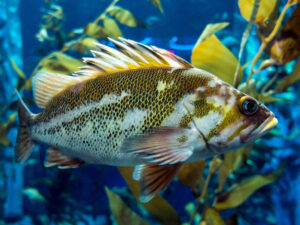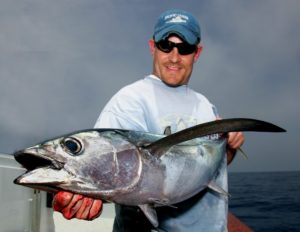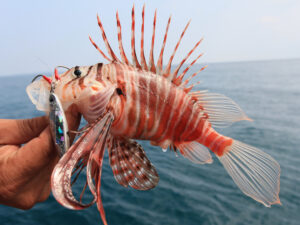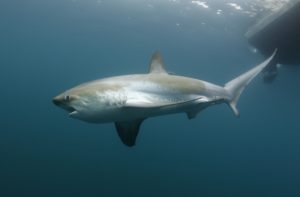In each issue of Sport Fishing magazine, a panel of five international expert ichthyologists identifies unusual and often amazing fishes in photos submitted by readers. Find out what they are and learn fascinating facts about them.
Antenna Fish from the Mexican Deep
QUESTION:
My brother was fishing in deep water off La Paz, Mexico — probably in 200 feet or so — trying for red snapper when he caught some of these fish. Can you identify it? The panga captain called it a “radio-antenna fish,” maybe because of the tall dorsal fin. Thanks.
Gary Evans
Santa Ana, California
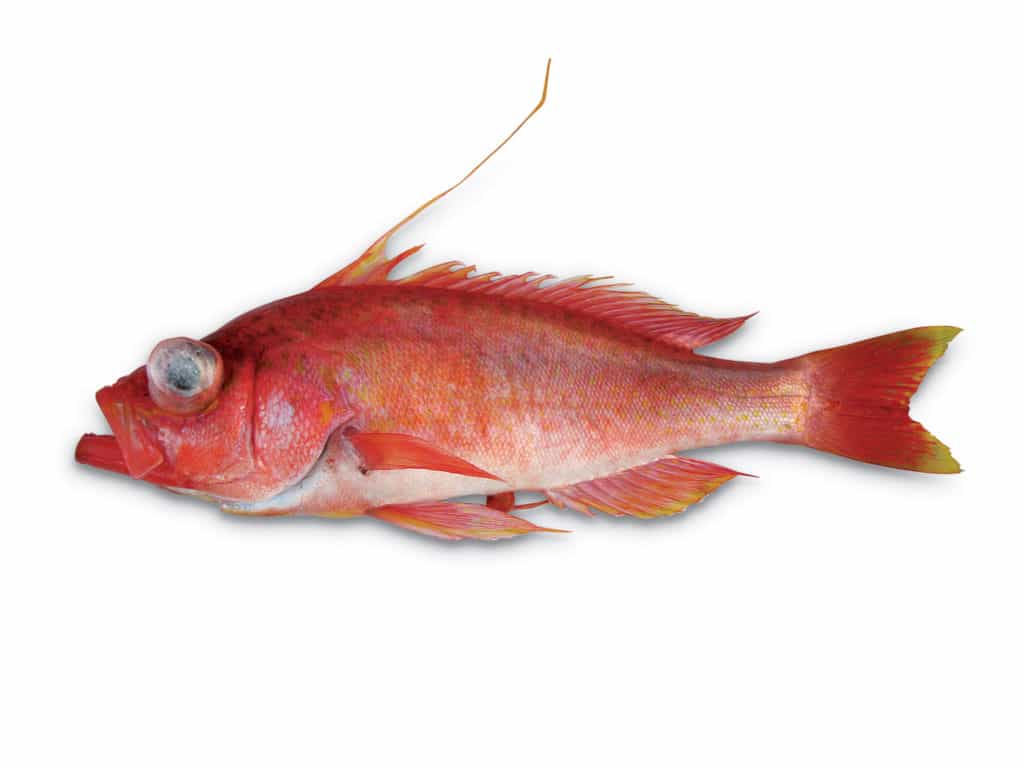
ANSWER:
Gary, that very long third dorsal spine and the yellow fin edges mean that you caught a hookthroat bass, Hemanthias signifer, a schooling reef fish found from Southern California to Peru, including the Gulf of California. Also known as the damsel bass, this species closely resembles the splittail bass, Hemanthias peruanus. However, the tail fin of a splittail has very long upper and lower lobes. Reaching only about 17 inches long, hookthroats are common from the Gulf of California southward to at least Panama. Hookthroats live in just under 100 feet to about 1,000 feet of water, and probably stay right near the bottom, likely near caves and crevices. I occasionally see them in fish markets in southern Baja and along the southern Mexican mainland. And the name hookthroat? If you look on the underside of this species’ head, on the throat, you will see a little divot (this is just visible in the photograph); that’s the “hook” that gives this species its name. The IGFA all-tackle-world-record damsel bass was taken in southern Costa Rica in 1995 and weighed 1½ pounds.
—Milton Love
Little Margot from Mississippi
QUESTION:
We caught this little dude in a minnow trap at our dock this August in Bay St. Louis, Mississippi. The trap was in only 2 feet of water, over some old oyster shells. I have been throwing cast nets and pulling a seine net in these same waters for decades, but I have never seen anything even remotely similar to this strange creature. It seems to have a face like a hind and a tail like a cusk. It even has a neon-green dot on its dorsal fin. Is this a native species? Does it get larger? Could this possibly be an undiscovered species? If it is, can I name it after my daughter? “Little Margot” has such a nice ring to it.
Capt. Sonny Schindler
Shore Thing Fishing Charters
Bay St. Louis, Mississippi
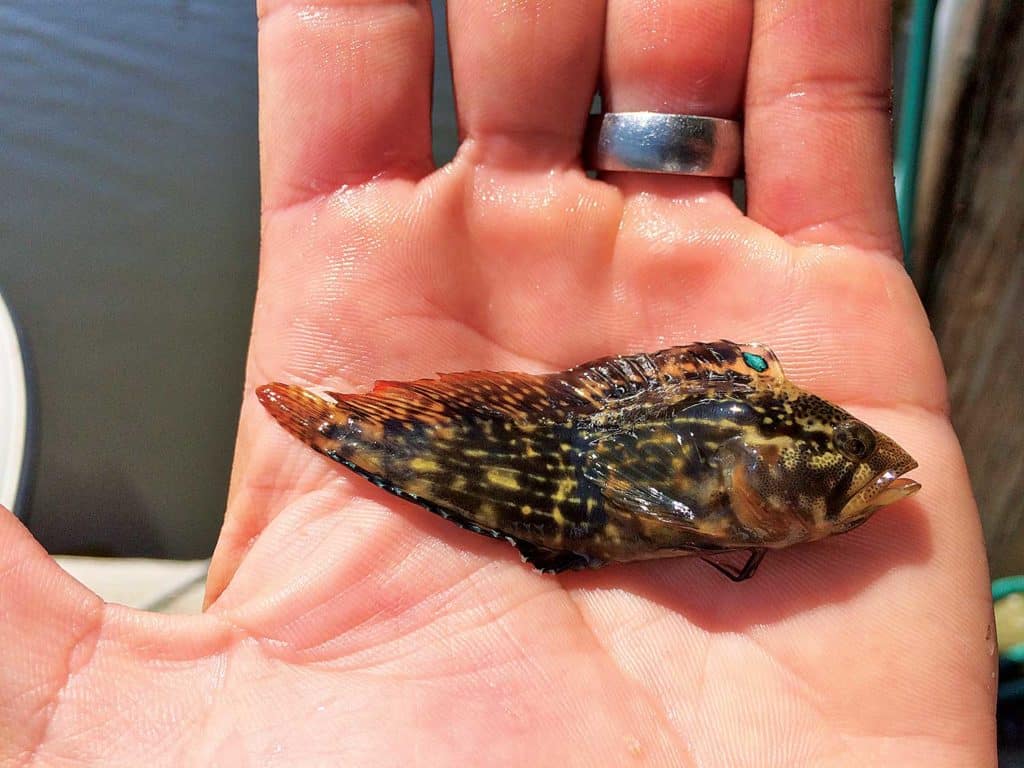
ANSWER:
Sonny, your catch is a striped blenny, Chasmodes bosquianus. Although they top out at about 4 inches, they’re voracious predators for their size. They live hidden in oyster shells or barnacle habitat, waiting for prey to swim by. Then they explode from their lair, engulf the morsel and return home. Striped blennies have a strange distribution, abundant in the western Gulf of Mexico but absent in the eastern Gulf. And on the Atlantic side, they’re present from northeast Florida north to New York. Living between the two separated populations is the similar Florida blenny. There are many blenny species in the Gulf and worldwide; blennies are one of the most diverse groups. And though they are not particularly colorful, their interesting habits make them fascinating aquarium pets.
—Bob Shipp
A Long Snout Without a Doubt
QUESTION:
I caught this fish off the bottom in 400 feet of water off Jupiter, Florida. It had lots of sharp spines. My fishing partner, who called it an orange roughy, said he has caught several over the years. A Web search told me it’s not an orange roughy, but I couldn’t find anything close to it. Any thoughts as to what this might be?
Stuart Montgomery
Jupiter, Florida
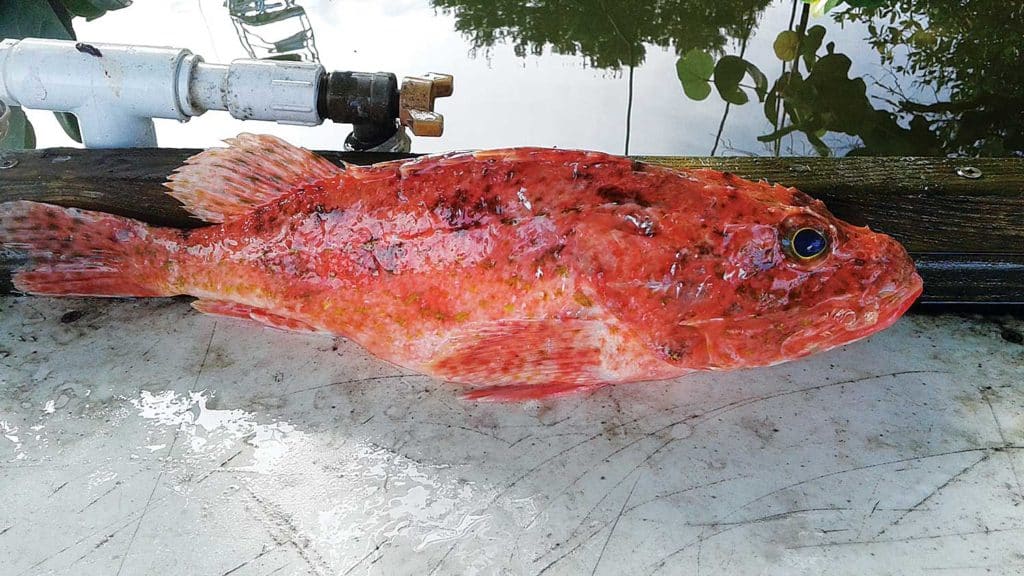
ANSWER:
Stuart, you appear to have caught a longsnout scorpionfish, Pontinus castor. This species is known to reach a length of about 1 foot, so your catch is quite large. The longsnout can be found on rocky bottoms from Bermuda through southeastern Florida, the Bahamas and islands in the greater Antilles chain, at depths between 150 and 1,350 feet. It’s likely that the species’ range is greater than reported. The longsnout scorpionfish sometimes puts in an appearance at fish markets. Although I haven’t seen a report on the longsnout scorpionfish’s edibility, many scorpionfishes are highly regarded as table fare, and I’m sure this one is no different. Like other scorpionfishes, the longsnout has venom-producing tissue associated with spines in its dorsal, pelvic and anal fins, and can deliver a painful sting if an angler is jabbed.
—Ray Waldner
Hawaii’s Flower Bass
QUESTION:
I got this fish off the coast of Hawaii while bottomfishing in 720 feet. We have many types of deep-sea groupers, but I haven’t seen this one on any state-record lists. It measured about 8 inches long and weighed perhaps a half-pound. I caught it using a piece of skipjack for bait on 100-pound leader; we were going for much bigger fish.
Dave Haraguchi
Hilo, Hawaii
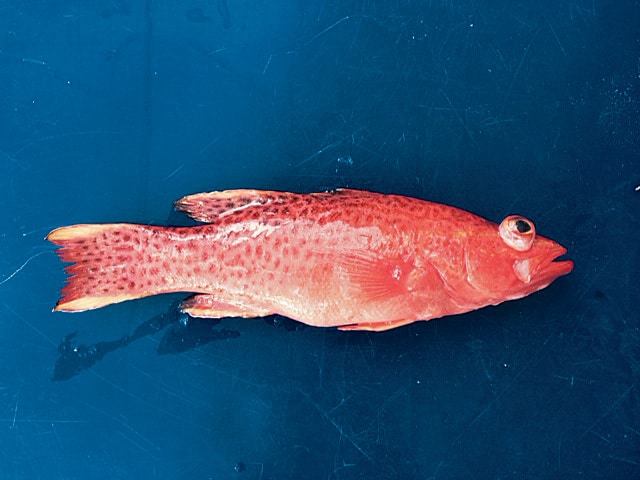
Dave, you’ve caught a pretty little spotted basslet (Liopropoma maculatum), a type of deep-sea grouper that occurs around seamounts and over deep tropical reefs from Okinawa, Japan, and Taiwan to the Hawaiian Islands. Known in Japan as hanasuzuki, or “flower bass,” this basslet grows to only around 10 inches long, living at depths of 600 to 800 feet over rocky bottoms. The family Serranidae (which includes groupers) has more than 30 species of basslets in the genus Liopropoma, all of which have roughly similar body shapes. However, the spotted basslet is relatively easy to identify due to its unique coloration pattern of dark-reddish-brown blotches on its body, which contrast with the strong yellow color of the fin tips.
—Ben Diggles
Salty Dog
QUESTION:
We caught this big snapper in 300 feet of water. I believe it’s a dog snapper but want to confirm that.
Capt. Antonio “Tuba” Amaral
Canavieiras, Brazil
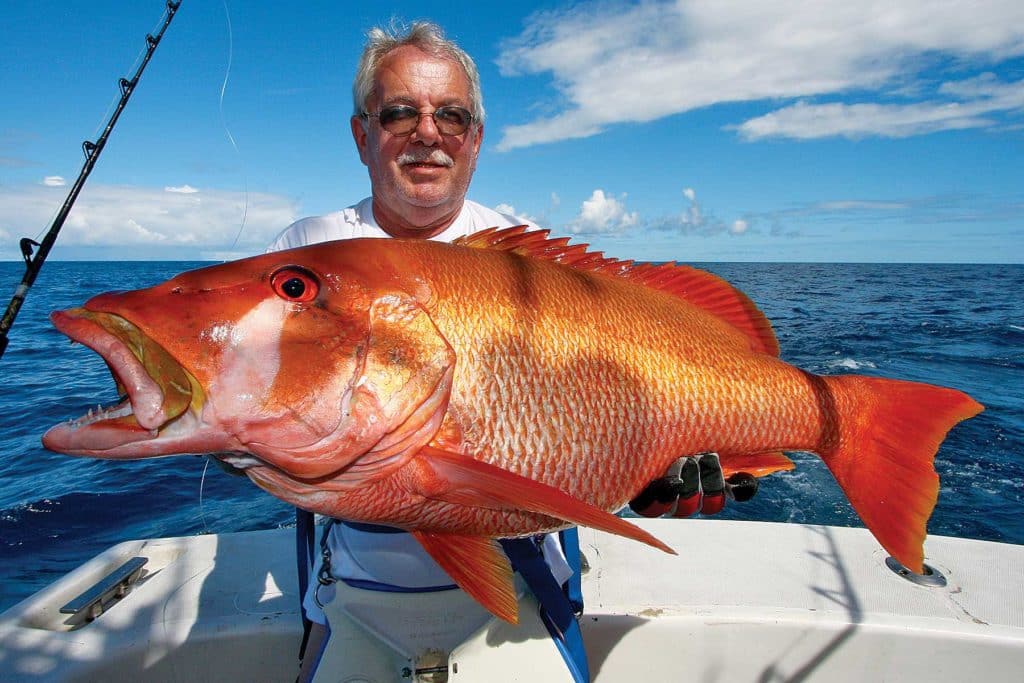
ANSWER:
Nice catch, captain! The fish in question looks very much like a southern or Caribbean red snapper, Lutjanus purpureus, but based largely on the location of capture, the fish’s dentition, the oblique scale rows above the lateral line, and the small amount of yellow pigmentation around the mouth and on the fins, I believe it is a dog snapper, L. jocu, as you suggested. The pale patch below the eye is a characteristic of dog snapper, but pale suborbital areas sometimes occur in L. purpureus as well. I can’t see the anal fin clearly, due to the way the fish is being held; it’s partially collapsed, which might give it a pointed appearance. Dog snapper characteristically have a blue line or a series of blue dots below their eyes, and a couple of blue dots can be seen on your catch. Both L. jocu and L. purpureus have long pectoral fins, clearly visible in your photo.
Dog snapper have been reported from New England, but they commonly range from Florida south through northeastern Brazil, including the Gulf of Mexico and Caribbean Sea. This species also occurs in the eastern Atlantic. Dog snapper are excellent table fare but have been implicated in cases of ciguatera poisoning, so be wary of eating individuals caught around areas with coral reefs, and especially cautious of consuming large specimens.
—Ray Waldner
Read Next: Strange Fishes From the Deep — Rare Domine and More
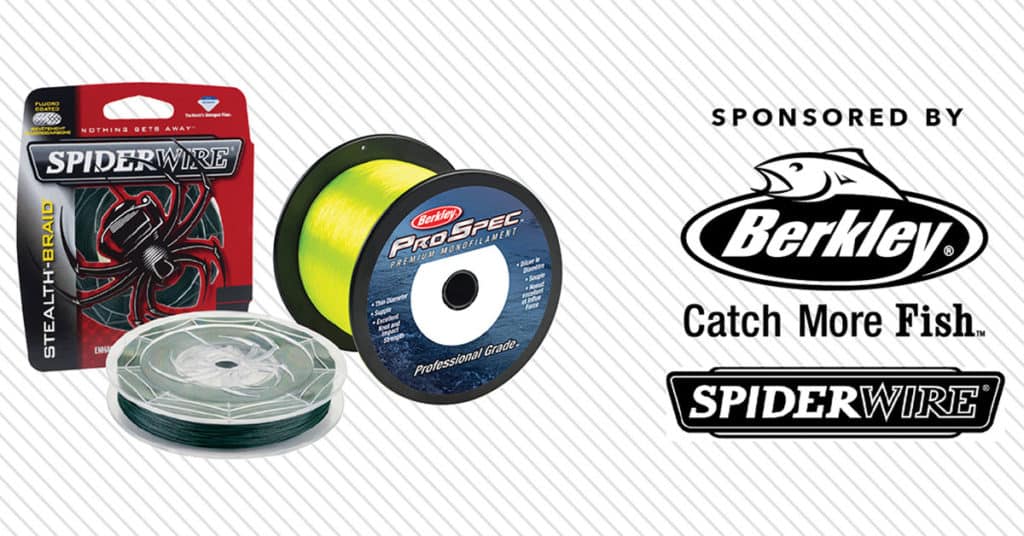
CHALLENGE OUR EXPERTS (And Win Up to 10,800 Yards of Line!)
Send in your question and any relevant photos of your mysterious catch or observation for our experts’ ID and feedback. If we publish your question and you have a shipping address within the United States or Canada, you’ll win a 3‑pound spool of Berkley Pro Spec ocean-blue or fluorescent-yellow monofilament (1,000 to 10,800 yards, depending on line strength) or a 1,500‑yard spool of Spiderwire Stealth braid up to 100‑pound‑test! Send questions and images via email to fishfacts@sportfishing.com (include your hometown) or via post to Sport Fishing Fish Facts, 460 N. Orlando Ave., Suite 200, Winter Park, FL 32789.

